Related Research Articles

Speed bumps are a class of traffic calming devices that use vertical deflection to slow motor-vehicle traffic in order to improve safety conditions. Variations include the speed hump, speed cushion, and speed table.

A speed limit is the limit of speed allowed by law for road vehicles, usually the maximum speed allowed. Occasionally, there is a minimum speed limit. Advisory speed limits also exist, which are recommended but not mandatory speeds. Speed limits are commonly set by the legislative bodies of national or local governments.
Road signs in South Korea are regulated by the Korean Road Traffic Authority.
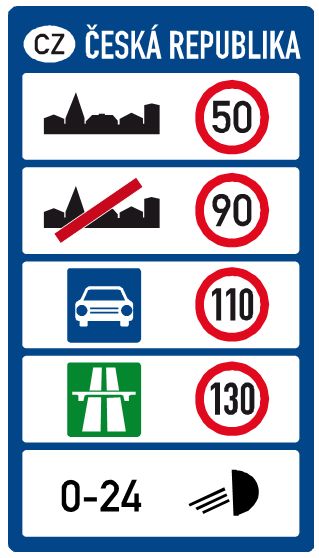
Speed limits in the Czech Republic vary depending on the type of road, and whether the road is within a settlement or not. The top speed limit is 130 km/h (81 mph) for motorways outside of settlements, whereas on regular roads within a settlement the speed limit is 50 km/h (31 mph). outside of the settlement and other than motorway the speed limit is 90 km/h. Various other special restrictions are applied for certain types and weight categories of vehicle.
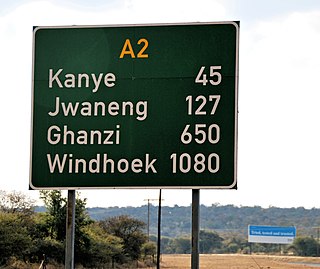
Road signs in Botswana are based on the SADC-RTSM, a document designed to harmonise traffic signs in member states of the Southern Africa Development Community.
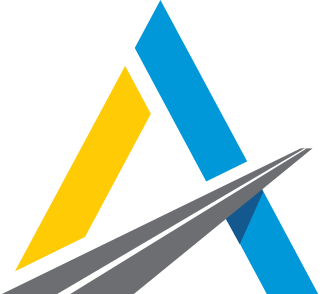
Road signs in Ukraine are governed by a combination of standards set out by the Vienna Convention on Road Signs and Signals, the European Union (EU), and Ukraine Transport and Roads Agency. Ukrainian signs are similar to the signs of other post-Soviet states and are set out in 7 separate categories based on meaning: Warning, priority, prohibitory, mandatory, information, guide, and additional plates.

Bosnia and Herzegovina is a signatory of Vienna Convention on Road Signs and Signals. Therefore, road signs do not differ much from the rest of Europe, such as Croatia, North Macedonia and Serbia. Ministry of Transportation of Bosnia and Herzegovina regulates them. Bosnia and Herzegovina drives on the right as with the rest of Europe, except for Cyprus, Ireland, Malta and the United Kingdom. Bosnian and Herzegovinan road signs have two scripts, Latin and Cyrillic script.

Road signs in Cambodia are standardized road signs are similar to those used in Europe but much of it resembles road signage systems used in South American countries with certain differences. The designs of road signage match their neighbours of Thailand and Malaysia, both of which adopt a modified version of the South American road signage system. Until the early 1980s, Cambodia closely followed American, European, Australian, and Japanese practices in road sign design, with diamond-shaped warning signs and circular restrictive signs to regulate traffic. Unlike Thailand and Malaysia, Cambodia does not use the FHWA Series fonts typeface, favouring Helvetica instead.
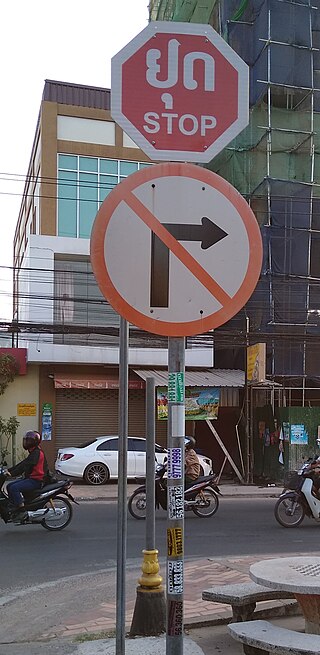
Laos traffic signs use Lao, the national language of Laos. However, English is also used for stop and important public places such as tourist attractions, airports, railway stations, and immigration checkpoints. Both Lao and English are used on directional signage.
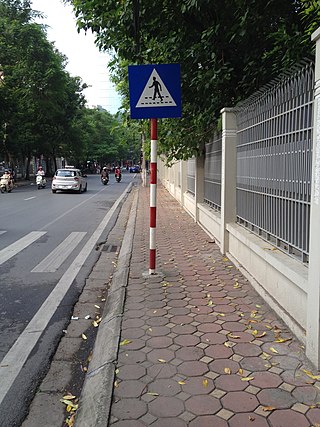
These road signs are used in Vietnam following Chinese and French practice. Some signs are written in both Vietnamese and English. The signs are prescribed by the Ministry of Transportation of Vietnam.
Road signs in Georgia are similar to the road sign system of other post-Soviet states that ensure that transport vehicles move safely and orderly, as well as to inform the participants of traffic built-in graphic icons. However, some road signs look a bit different from Soviet ones and closer to the European ones. These icons are governed by the Vienna Convention on Road Traffic and Vienna Convention on Road Signs and Signals.
In Saudi Arabia, road signs differ by locale, but they do tend to closely follow European practices with certain distinctions. Road signs display text in Arabic language. Distances are displayed in metric units and in Eastern Arabic numerals.
Road signs in Kyrgyzstan are similar to the road sign system of other post-Soviet states that ensure that transport vehicles move safely and orderly, as well as to inform the participants of traffic built-in graphic icons. These icons are governed by the Vienna Convention on Road Traffic and Vienna Convention on Road Signs and Signals.

Road signs in Lithuania ensure that transport vehicles move safely and orderly, as well as to inform the participants of traffic built-in graphic icons. These icons are governed by the Vienna Convention on Road Traffic and Vienna Convention on Road Signs and Signals.

The road signs, used on the Serbian road network, are regulated by the "Regulation of Traffic Signs", which was last time modified in 2017.

E 30 is one of the main roads of the United Arab Emirates (UAE). The road connects the city of Abu Dhabi and Al Ain. It is colloquially called Abu Dhabi-Al Ain Truck Road, but is officially named Al Rawdah Road. and is approximately parallel with E 22 - Al Ain Road.

Road signs in Russia ensure that transport vehicles move safely and orderly, as well as to inform the participants of traffic built-in graphic icons. These icons are governed by the Vienna Convention on Road Traffic and Vienna Convention on Road Signs and Signals. Similar road signs are also used in other post-Soviet countries.

Road signs in Portugal are governed by the "Regulamento de Sinalização do Trânsito" of the Republic of Portugal.
Road signs in the Republic of Bulgaria were introduced by the Road Traffic Act and are regulated by:

Road signs in Latvia ensure that transport vehicles move safely and orderly, as well as to inform the participants of traffic built-in graphic icons. These icons are governed by the Vienna Convention on Road Traffic and Vienna Convention on Road Signs and Signals. The system is covered in Ceļu satiksmes noteikumi and the standards documents LVS 77–1:2016 "Ceļa zīmes. 1. daļa: Ceļa zīmes", LVS 77-2:2016 "Ceļa zīmes. 2. daļa: Uzstādīšanas noteikumi" and LVS 77-3:2016 "Ceļa zīmes. 3. daļa: Tehniskās prasības".